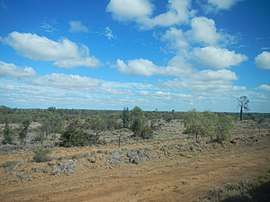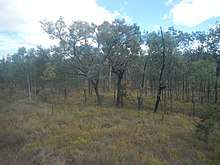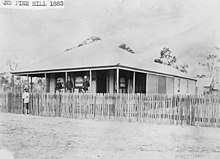Pine Hill, Queensland
Pine Hill is a former rural locality in the Barcaldine Region, Queensland, Australia.[2] In the 2016 census, Pine Hill had a population of 3 people.[1]
| Pine Hill Queensland | |||||||||||||||
|---|---|---|---|---|---|---|---|---|---|---|---|---|---|---|---|
 Grazing land beside the Central Western railway in Pine Hill, 2013 | |||||||||||||||
 Pine Hill | |||||||||||||||
| Coordinates | 23.5055°S 147.1052°E | ||||||||||||||
| Population | 3 (2016 census)[1] | ||||||||||||||
| • Density | 0.0033/km2 (0.0086/sq mi) | ||||||||||||||
| Postcode(s) | 4724 | ||||||||||||||
| Area | 904.9 km2 (349.4 sq mi) | ||||||||||||||
| Time zone | AEST (UTC+10:00) | ||||||||||||||
| Location |
| ||||||||||||||
| LGA(s) | Barcaldine Region | ||||||||||||||
| State electorate(s) | Gregory | ||||||||||||||
| Federal Division(s) | Maranoa | ||||||||||||||
| |||||||||||||||
On 22 November 2019 the Queensland Government decided to amalgamate the localities in the Barcaldine Region, resulting in five expanded localities based on the larger towns: Alpha, Aramac, Barcaldine, Jericho and Muttaburra. Pine Hill was incorporated into Alpha.[3][4][5]
Geography

The Central Western railway line forms the southern boundary of the locality with the Capricorn Highway forming the eastern part of the southern boundary.[6]
The Drummond Range forms the western part of the locality. A number of creeks rise in the slopes of the range and flow variously west and north, all eventually becoming tributaries of the Belyando River within the North East Coast drainage basin.[6]
The predominant land use is grazing on native vegetation.[6]
History

The Central Western railway line reached Pine Hill in 1883 with the Pinehill railway station at 23.6503°S 146.9565°E its terminus.[7] The station buildings were completed in July 1883.[8] According to the Queensland Railways Department, the railway station was so named because of the surrounding ridges were once covered in cypress pine.[9]
On August 1883 there was a land sale for 56 town lots and 180 country lots at Pine Hill.[10] The sale was successful yielding £3000 with buyers planning to build hotels and shops in the new town, although the newspaper of the day speculated that the land might be worthless in two years (presumably in the expectation that Pine Hill would not remain the terminus).[11] The railway line opened 1 November 1883.[12] The Queensland National Bank relocated their business from Bogantungan (the previous terminus) to Pine Hill in November 1883.[13] The town was described in December 1883 as:[14]
"There is dust everywhere, not only in the streets but in the houses.You breathe it, you eat it, you drink it, you sniff it, touch what you will it is there. It sometimes almost blinds you, and it will no doubt assist in producing premature deafness in some cases, for your ears get filled with dust and thus all the five senses are affected ... it ought to have been named The Dust Flat".
On 22 September 1884 the railway line had reached its new terminus Alpha and Pine Hill was described as "unsuited for permanent settlement". There was criticism of the Queensland Government for profiting from land sales in short-lived terminus towns like Pine Hill.[15]
Pine Hill State School opened circa 1884 but closed in 1905. It reopened on 25 January 1926 but closed circa 1946.[16]
Although the town's streets and allotments can still be seen on maps, there is no evidence of any building there today. The town was to the immediate south of the railway station in what is now the northernmost part of the Port Wine locality.[6]
Education
There are no schools in Pine Hill. The nearest primary school is in Alpha. The nearest secondary school is in Alpha but only to Year 10. The nearest secondary school to Year 12 is in Emerald.[6] Boarding schools and distance education are other options.[17]
References
| Wikimedia Commons has media related to Pine Hill, Queensland. |
- Australian Bureau of Statistics (27 June 2017). "Pine Hill (SSC)". 2016 Census QuickStats. Retrieved 20 October 2018.

- "Pine Hill - locality in Barcaldine Region (entry 47110)". Queensland Place Names. Queensland Government. Retrieved 10 June 2019.
- "Recent place name decisions". Queensland Government. 22 November 2019. Archived from the original on 22 October 2019. Retrieved 15 January 2020.
- "Proposed Locality Boundaries and Names: Barcaldine Regional: Alpha, Aramac, Barcaldine, Jericho and Muttaburra" (PDF). Queensland Government. 17 May 2019. Archived (PDF) from the original on 15 January 2020. Retrieved 15 January 2020.
- "Locality Boundaries and Names: Barcaldine Regional Council: Alpha, Aramac, Barcaldine, Jericho and Muttaburra" (PDF). Queensland Government. 17 May 2019. Archived (PDF) from the original on 15 January 2020. Retrieved 15 January 2020.
- "Queensland Globe". State of Queensland. Retrieved 13 August 2019.
- "Pinehill - railway station in the Barcadine Region (entry 26860)". Queensland Place Names. Queensland Government. Retrieved 13 August 2019.
- "MOUNT BRITTON". The Brisbane Courier. XXXVIII (7, 969). Queensland, Australia. 27 July 1883. p. 3. Retrieved 13 August 2019 – via National Library of Australia.
- "SKETCHER". The Queenslander (2456). Queensland, Australia. 11 April 1914. p. 8. Retrieved 13 August 2019 – via National Library of Australia.
- "Classified Advertising". The Queenslander. XXIV (410). Queensland, Australia. 4 August 1883. p. 22. Retrieved 13 August 2019 – via National Library of Australia.
- "BOGANTUNGAN". Morning Bulletin. XXXI (4818). Queensland, Australia. 4 September 1883. p. 3. Retrieved 13 August 2019 – via National Library of Australia.
- Kerr, John (1990). Triumph of narrow gauge : a history of Queensland Railways. Boolarong Publications. p. 224. ISBN 978-0-86439-102-5.
- "MISCELLANEA". The Telegraph (3, 469). Queensland, Australia. 27 November 1883. p. 2. Retrieved 13 August 2019 – via National Library of Australia.
- "The Western Champion". The Western Champion. V (235). Queensland, Australia. 12 December 1883. p. 2. Retrieved 13 August 2019 – via National Library of Australia.
- "Current Notes". The Capricornian. 10 (37). Queensland, Australia. 13 September 1884. p. 14. Retrieved 13 August 2019 – via National Library of Australia.
- Queensland Family History Society (2010), Queensland schools past and present (Version 1.01 ed.), Queensland Family History Society, ISBN 978-1-921171-26-0
- "Distance Education". Education. Queensland Government. 25 July 2019. Archived from the original on 7 August 2019. Retrieved 7 August 2019.